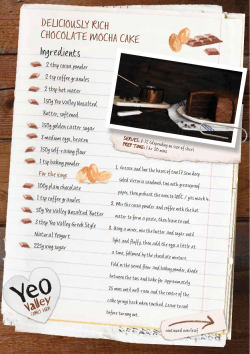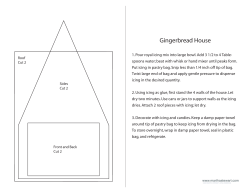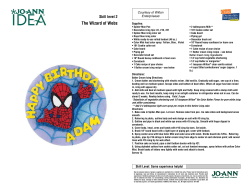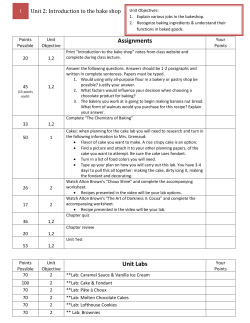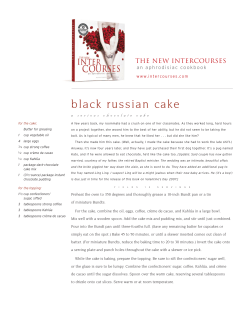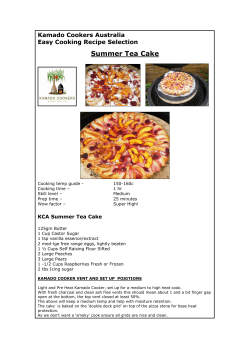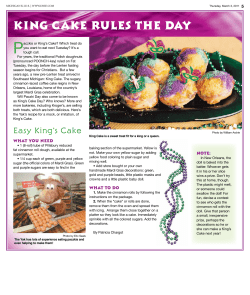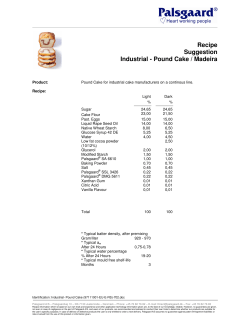
A BEGINNER’S GUIDE TO DECORATING A CAKE conjunction with CraftyCrayon.com 2005
A B EG INN ER’ S GU ID E TO D ECOR ATING A CA K E Compiled & Designed by Tabula Rasa i-Publishing Co. in conjunction with CraftyCrayon.com 2005 You are hereby granted re-sell rights to this eBook in this format as long as original remains exactly intact in all ways. Copyright 2005 © Tabula Rasa Interactive Publishing Co. and its licensors 2005. All Rights Reserved. www.craftycrayon.com TABLE OF CONTENTS Decorate Your Cake and Eat it Too Step 1: Prepare the Icing Step 2: Level the Cake Step 3: Assemble a Decorating Bag Step 4: Put in the Filling Step 5: Ice the Cake Step 6: Create Borders Add the Final Touches www.craftycrayon.com DECORATE YOUR CAKE AND EAT IT TOO A beautifully decorated cake can add delight to any special occasion. It's a personal touch that will be appreciated by everyone present (even those watching their waistlines). And while anyone can slap some frosting or sprinkle some powdered sugar on a cake, true decoration takes patience and skill. It also calls for a little imagination. We'll explain what you'll need to wow the folks who will get to enjoy your baking prowess. Just remember: this is one case where looks are definitely everything--at least until someone takes the first bite. Before you begin… The cake you'll be decorating must be completely cooled before any icing even gets near it. When it's finished baking, let it cool in the pan for 15 to 20 minutes before placing it on a cooling rack. Following that, it will take several hours to cool. You might even consider baking the cake the day before you decorate it, and then refrigerating it overnight. You can also prepare and refrigerate the icing beforehand if you're so inclined. www.craftycrayon.com Another key to successful decorating is knowing the overall look you want before you start. Take a look at some pictures of decorated cakes (bridal or food-related magazines are a good source), or visit a local bakery for some ideas. Once you know what you like, it'll be easier to create something dazzling. STEP 1: PREPARE THE ICING Any type of icing will work, including ready-made icing you can buy at the store. We'll discuss standard icing rather than glazes or royal icing (which involve a different set of rules--and aren't for the beginner). Basically you just want it to be smooth and free of air pockets. It should look and feel light and fluffy, with a fairly thin consistency, so it's easy to spread. Mix the icing with a rubber spatula or an electric mixer (use a paddle attachment and set the mixer on the lowest speed). You can add water or milk to thin the icing as needed. It should hold about a 1/4-inch peak when properly thinned. Once you're finished mixing, place a small amount in a separate bowl. This will be used for the base layer (explained in Step 5). www.craftycrayon.com STEP 2: LEVEL THE CAKE With a long, thin knife, flatten the cake's top by cutting away just enough to remove any roundness. This will create a level surface on which you can more easily place any decorations (such as borders, flowers, and the like). Measure the sides with a ruler so you're sure you'll be cutting off an even amount, then mark an even height on each side to use as a guide. Cut the remaining section in half horizontally (measuring and marking the sides again) and place the top layer aside. You should now have two, equally sized layers with flat (not angled or rounded) tops. Place the bottom half of the cake on a cardboard round or a platter. STEP 3: ASSEMBLE A DECORATING BAG Decorating bags come in various models. If you want to get into cake decorating for the long haul, purchase several featherweight bags, which are made of washable polyester that's specially coated to prevent leaks. If you're a one-time-only decorator, use a disposable (plastic) or parchment paper bag. You can find these ready-made at most grocery stores. www.craftycrayon.com Next, you'll insert the coupler (available at larger grocery stores, many department stores, and specialty cookware shops).While you can use a bag without one, a coupler will help you keep your decorating details steady. You can also use it to change decorating tips while using the same bag (otherwise you'll need a different bag for each tip). To use a coupler: Twist its ring off and push the cone-shaped base (narrow end first) into the open end of the bag and down toward the pointed end as far as it will go (be gentle if you're using paper). If you're using a featherweight bag, use a pen to mark a line where you can see the circular outline of the bottom threads where the ring screws onto the base. Push the base back into the bag and cut the end at the line. Then push the base back down toward the point until its end and the bottom threads are showing. www.craftycrayon.com If you're using a disposable plastic or a paper bag, push the coupler base into the bag, then trim the bag about one-quarter inch below the bottom edge of the coupler. Choose a decorating tip that has a large, round opening (you'll be using it first), and attach it to the coupler base. Then put the ring over the tip and screw it into place. STEP 4: PUT IN THE FILLING Fill the cone with icing about halfway--you'll want to start with a small amount so you can get the hang of the technique. Don't overfill the bag, or the icing will end up on you instead of the cake. Twist the bag closed just above the icing. This will push the icing down toward the tip. Squeeze a small amount of icing into the icing bowl to make sure there's no air in the bag. Using a large, round tip on the decorating bag, squeeze a thick border of icing along the top edge of the bottom layer. This edge will prevent any filling from spilling out the side of the cake once it's put together. www.craftycrayon.com When the entire edge is covered, put the filling in. You can use more icing or something different such as fruit preserves, pudding, custard, whipped cream, etc. Start at the center of the cake and work your way out toward the border, creating a nice, thick layer. When you're finished, gently replace the cake's top layer. Make sure the layer is sitting level by measuring the height on all sides. If necessary, press down slightly on any areas that aren't laying flat, using the border and filling as a moldable cushion. Chill the cake in the refrigerator for 15 to 20 minutes before moving on to the next step. STEP 5: ICE THE CAKE You'll ice the cake using at least two layers. The first, called the "crumb" layer, is a base coat that will keep crumbs from getting into the outer layers of icing. To apply the crumb layer, take a flexible rubber spatula and spread the icing you placed in the small bowl over the entire cake. Start with the sides and then move to the top. You want a thin, even layer that will hold in the www.craftycrayon.com crumbs. Avoid touching the cake with the spatula--this will minimize crumbs. Discard any remaining frosting left in the small bowl (never mix the base frosting with the rest of the frosting). Allow this base layer to dry for a minimum of 20 minutes before moving on to the next layer. When the base coat is dry, clean the spatula and then use it to smooth a large amount of fresh frosting from the large bowl onto the cake's sides. Continue covering the sides, remembering not to let the spatula touch the cake (only the icing). You can do this by always using more icing than you think you'll need. As you're applying the icing, move slowly and try to keep it looking smooth. When the sides are finished, move to the top. Once the entire cake is covered, you can decide if you want to add a third layer of icing. At this point it's a matter of personal taste. Next, smooth the icing on the cake's top with a long, flat spatula or ruler. Just hold either item at an angle and drag it gently across the cake's top. This will create a flat surface on which you can decorations. place flowers Make any and other necessary finishing touches by dipping a knife or spatula in hot water and smoothing the icing out. www.craftycrayon.com STEP 6: CREATE BORDERS Borders add elegance and style to what would otherwise be an ordinary looking cake, but creating them takes practice. Usually they're placed around the top and bottom edges, but sometimes just the bottom. Where you put them will depend on the cake's design and shape. Use your best judgement to decide where your borders should be. We'll discuss the "shell border," which is one of the most common styles. To practice making one, you'll need a star-shaped tip attached to your bag. You'll also want your icing to be of medium consistency (it should hold a 1/2-inch peak). Add some powdered sugar to thicken it as needed. Now use a sheet of waxed or parchment paper as your practice surface. Hold the bag firmly at a 45-degree angle, with the base of its twisted top between your thumb and forefinger. Place your other hand lightly against the bag to keep it steady. Squeeze some frosting out, keeping the tip about 1/4-inch from the paper surface. Use steady pressure until there's a good-sized shell. It's not necessary to move your hand; just let the icing form its own shape. Then move the bag horizontally, just enough to make another shell behind the first. Continue www.craftycrayon.com squeezing and releasing in this manner to create a line of repeated shells that are uniform in shape and size. Once you get the hang of creating borders, you can move on to the real thing. Begin along the top edge of the cake (if you prefer to have a border there) and create a border that covers the edge all the way around. Do the same along the bottom edge, but with a larger star tip so it creates a thicker border that will give the cake balance and style. ADD THE FINAL TOUCHES It's the little details that can really pull the cake together and dazzle its admirers. However, certain touches (like flowers made of icing) can be the most difficult decorations to create. In the beginning, it's best to stick with simpler alternatives that work just as well. Try fresh flowers, for example. Ask your florist for some that haven't been sprayed with pesticides (or gather some from your yard), then freeze them in plastic bags before www.craftycrayon.com placing them on the cake. Some flowers are edible (such as violets, marigolds, apple blossoms, and such), so ask your florist about those, too. Sprinkle some petals around the edge of the cake platter for a lovely finishing touch when the cake is served. You can also find ready-made decorations where baking items are sold. These not only include icing flowers, but also borders, beads, ruffles, figurines, and more. Or you can go for nontraditional decorating items such as toys. Candy, nuts, or colored sugar sprinkled over the top or formed into a pattern look good too. You can also practice using a small tip to write a special message in brightly colored frosting. Whatever you choose, the key is not to go overboard. This is one situation where less is definitely more. That is, unless you want seconds. www.craftycrayon.com Interested in purchasing more great eBooks like this one? Visit us online at http://www.craftycrayon.com Our digital goods are great! Crafty Crayon in conjunction with Tabula Rasa i-Publishing, Co. Visit us online for more quality ebooks at low prices: w w w . c r a f t y c r a y o n . c o m
© Copyright 2025
